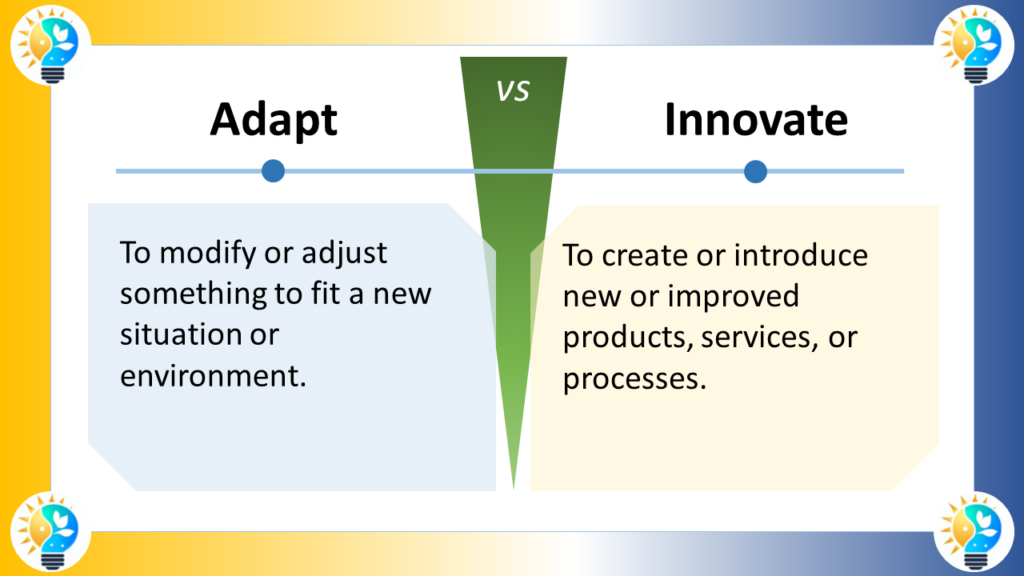Innovation and adaptation are two pivotal concepts in both the business world and everyday life, guiding how challenges are met and how new frontiers are explored.
While both are crucial for growth and survival, they serve distinctly different purposes and processes.

Definition
Innovate
Innovation involves creating something new or significantly improving an existing idea, product, or process. It often requires a novel approach and thinking outside the conventional boundaries.
- Novelty: Introducing new methods, ideas, or products.
- Improvement: Enhancing the quality or efficiency of something that already exists.
- Disruption: Often causes a fundamental change in how things are done or perceived.
Adapt
Adaptation refers to the process of modifying something to suit a new condition or environment. It focuses on survival and efficiency in a changing landscape.
- Change Management: Adjusting to new conditions, environments, or requirements.
- Survival: Ensuring continuity or improvement in performance under new or challenging conditions.
- Flexibility: The ability to change or be changed easily to fit different conditions.
More Synonyms on innovation, innovate and innovative:
- Adapt
- Advance
- Change
- Create
- Cultivate
- Devise
- Develop
- Discover
- Disrupt
- Evolve
- Experiment
- Fashion
- Generate
- Imagine
- Initiate
- Introduce
- Invent
- Modernize
- Originate
- Pioneer
- Progress
- Prototype
- Radicalize
- Reform
- Reinvent
- Renew
- Revolutionize
- Restructure
- Set Trends
- Transform
- Upgrade

Innovation is considered as a driving force in progress.
It includes the introduction of novel ideas, methods, or products that bring positive change and advancement.
For more information about innovations, check our glossary
Relationship and Relevance
Innovation and adaptation are interrelated yet distinct strategies used to respond to internal and external pressures. Innovation is about driving change through new ideas and inventions, often leading the way in market trends and setting benchmarks. On the other hand, adaptation is about responding to changes, whether they are market-driven, environmental, or operational, ensuring the entity or individual remains relevant and competitive.
The key difference between innovation and adaptation is:
Innovation refers to creating something new and different, often a significant breakthrough or paradigm shift. It involves developing novel ideas, methods or solutions that provide new value. Innovation is about doing things in fundamentally new ways.[1][2][3]
Adaptation, on the other hand, is about adjusting or modifying existing processes, products or approaches to better fit changing circumstances or requirements. Adaptation builds on what already exists and makes incremental improvements or adjustments. It is more about doing things better within the existing framework.[1][2][4]
In summary:
- Innovation is about creating something new and different, while adaptation is about modifying and improving what already exists.
- Innovation often involves disrupting the status quo, while adaptation works within the existing paradigm.
- Innovation requires more time and resources, as it involves developing something entirely new. Adaptation can be more efficient and predictable, as it builds on proven solutions.[1][2]
- Innovation happens more during periods of peace and stability, while adaptation occurs more during times of conflict and change when there is less time but more immediate feedback.[4]
So in essence, innovation is about transforming the way things are done, while adaptation is about refining and optimizing existing approaches. Both are important for organizations to stay competitive and responsive to changing conditions.[1][2]
Context for Using Each Term
- Innovate is typically used when discussing efforts to break ground with unique products or revolutionary methods.
- Adapt is more commonly associated with adjustments made in response to new challenges or altered circumstances.
Example of Utilization
A tech company might innovate by developing a new kind of wearable technology that introduces unique features not seen before in the market. Later, as competitors catch up and the market evolves, the same company might need to adapt its marketing strategy, device compatibility, or even the technology itself to meet the new market standards and consumer expectations.
FAQ
Q: Can a company both innovate and adapt at the same time?
A: Yes, many successful companies continuously innovate while adapting to changes in the market and technology. This dual approach can help a company stay ahead of competitors and effectively manage market dynamics.
Q: Which is more important, innovation or adaptation?
A: The importance varies depending on the context. In a rapidly changing industry, adaptation might be crucial for survival. In a stable environment, innovation might be key to breaking new ground and capturing market share.
Q: Are there industries where one is more important than the other?
A: Yes, in tech-driven industries like software or biotechnology, innovation is often more crucial due to the fast-paced nature of technological advancements. In contrast, industries like retail or hospitality may benefit more from adaptation strategies to respond to consumer behavior and market trends.
[1] Inside Outcomes – Innovation vs. Adaptation
[2] LinkedIn – Innovating in a Changing World
[3] Course Sidekick – Adapting and Innovating
[4] Moore Army – Learning Adaptation
[5] LinkedIn – Adaptation vs. Innovation: Which?

